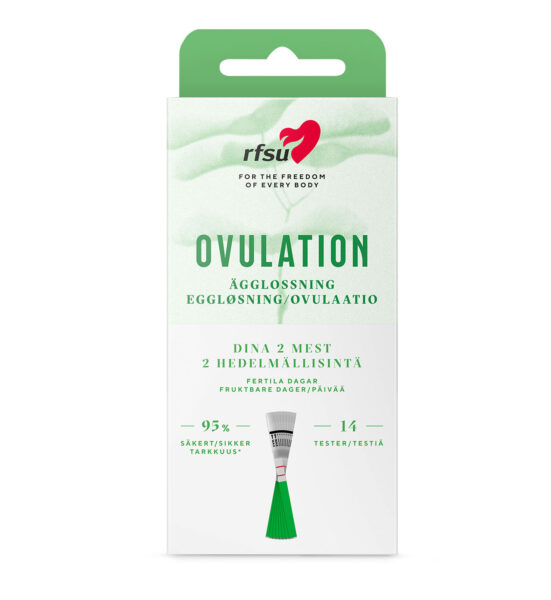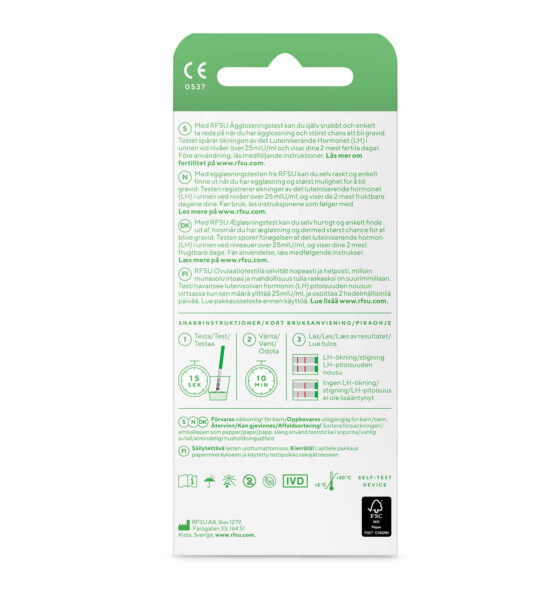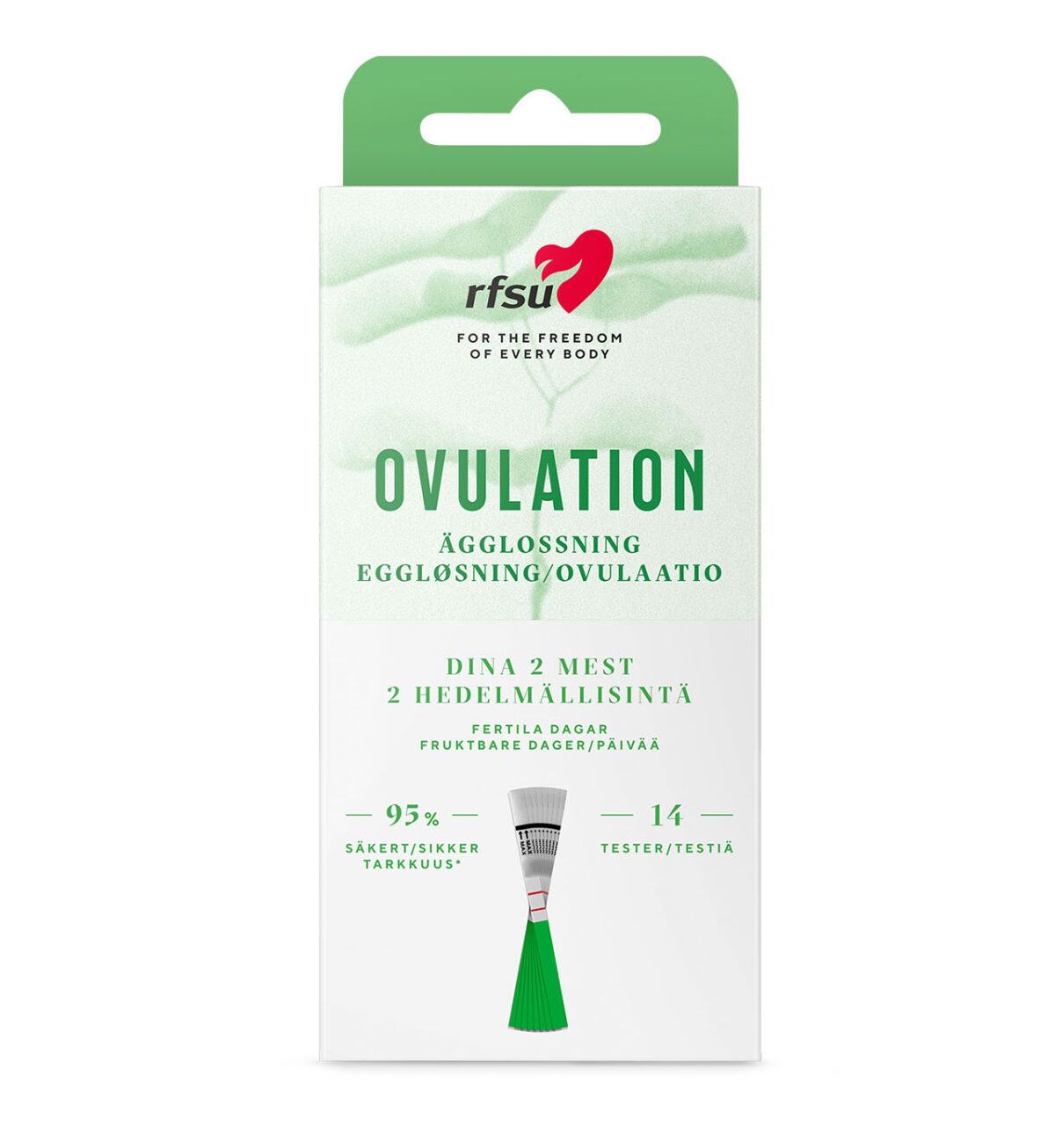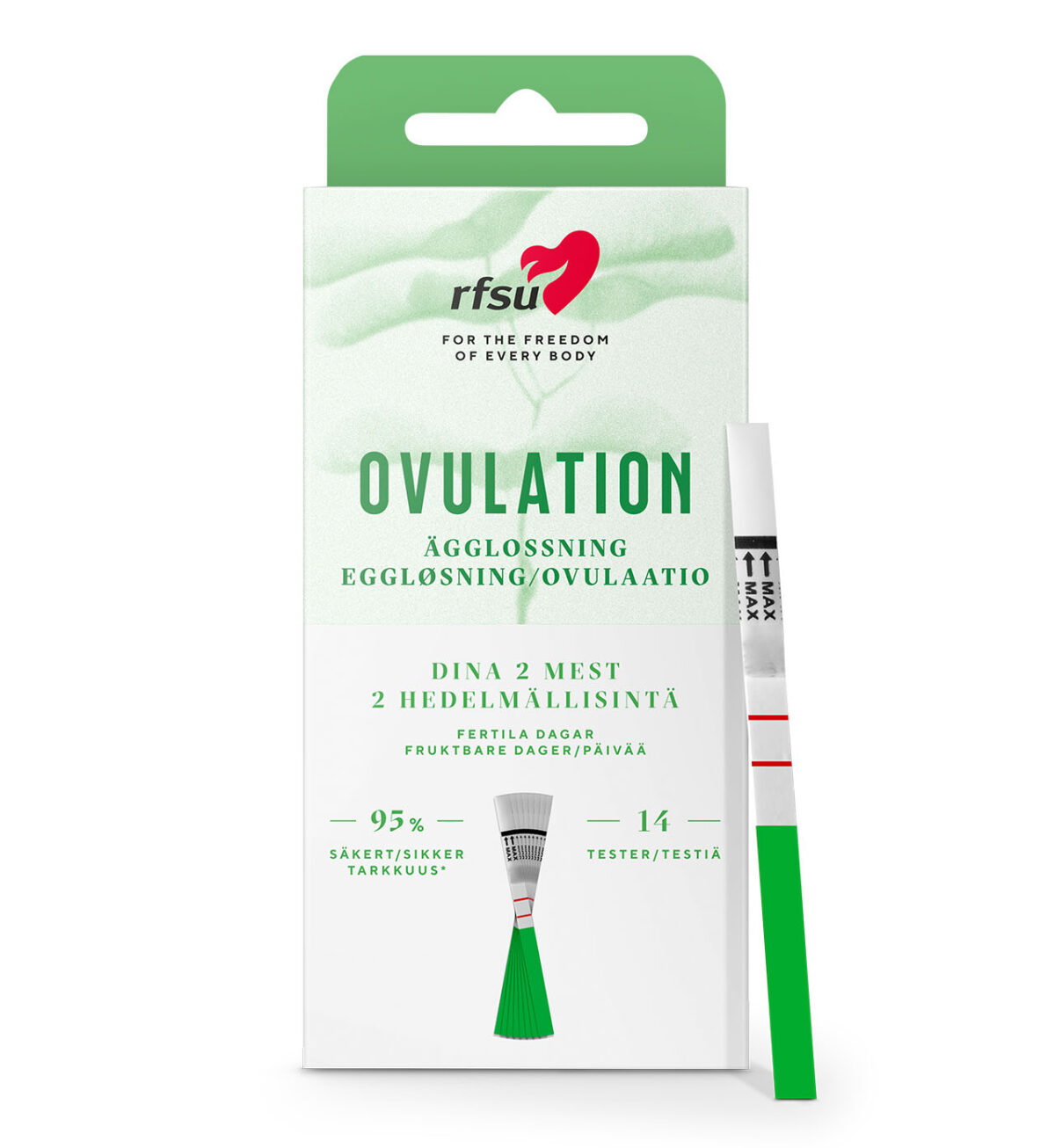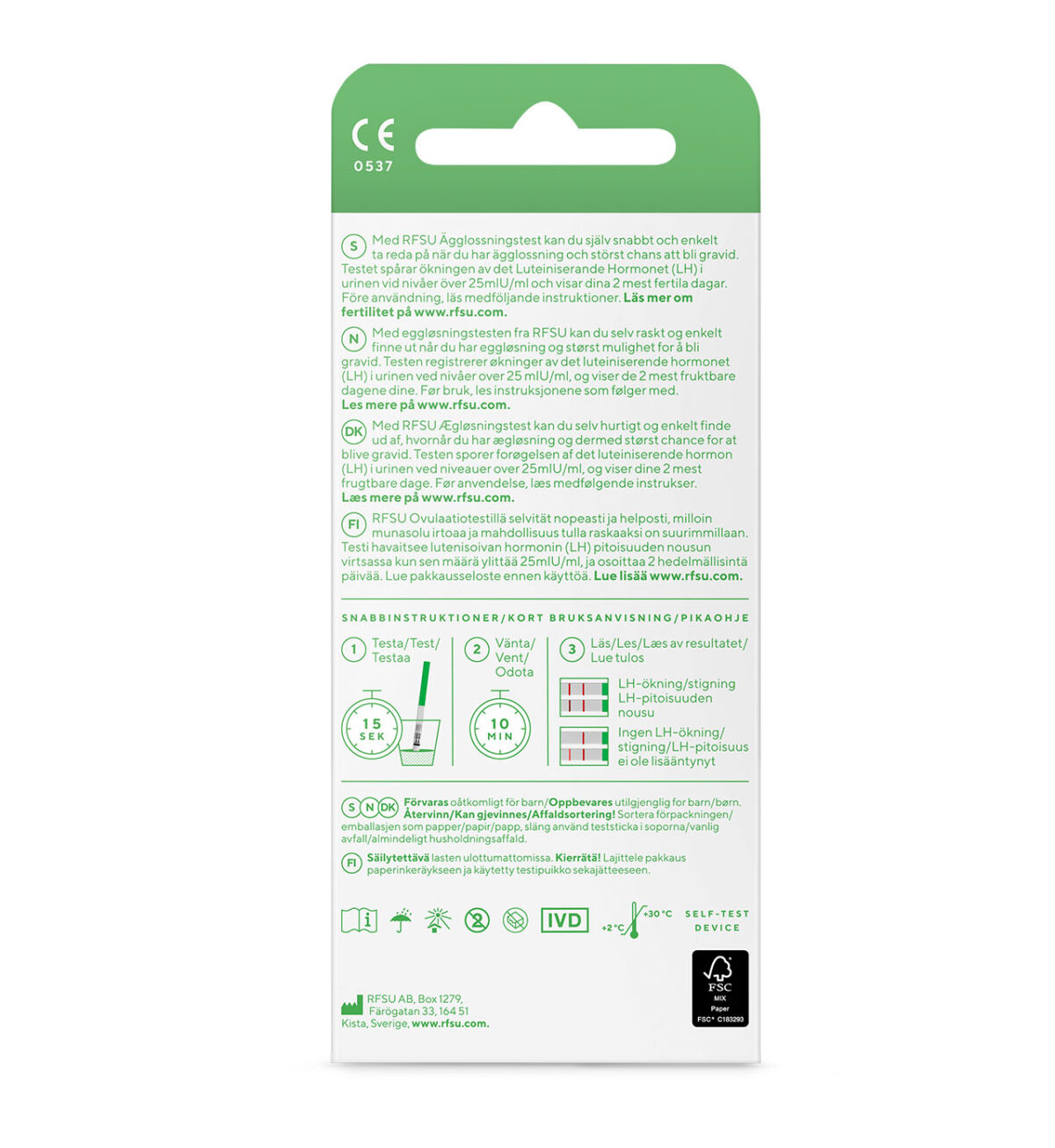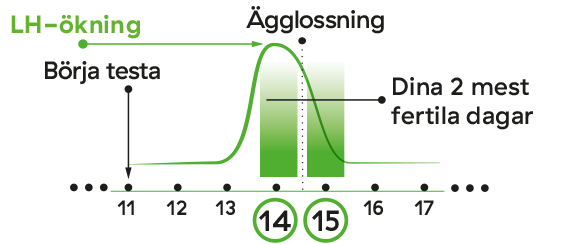-
Read more
With the RFSU Ovulation Test, you can quickly and easily find out when you ovulate and have the best chance of getting pregnant. The test tracks the increase in Luteinising Hormone (LH) in urine at levels above 25mlU/ml and shows your 2 most fertile days. In fertile women, ovulation occurs approximately in the middle of each menstrual cycle, days 12-16 before menstruation. Normally, the level of Luteinising Hormone (LH) rises dramatically before ovulation. The LH surge takes place about 24-48 hours before an egg is released from the ovaries, known as ovulation. During the LH surge, you are most fertile for the next 2 days. If you have sexual intercourse in the next 48 hours, your chances of getting pregnant increase.
About Ovulation test from RFSU
- Self-test that detects LH in urine.
- For single use.
- The test is over 95% reliable if the test instructions are followed carefully.
- Sensitivity: The test gives a result when the LH level in urine is 25 mIU/ml or higher.
- Before use, read the accompanying instructions.
- Sort the packaging as paper and the inner packaging (foil pouch) as plastic. Used test strips should be disposed of as household waste.
![ägglossnings-test-rfsu]()
-
How is LH hormone measured?
There are different methods to find out if you are ovulating.
Measuring the Luteinising Hormone (LH) is more reliable than the older methods of examining your secretions or measuring your body temperature. You can measure LH hormone yourself at home using ovulation tests.
In fertile women, ovulation occurs approximately in the middle of each menstrual cycle, on days 12-16 before menstruation. Normally, the level of the LH hormone rises drastically before ovulation. The LH surge takes place about 24-48 hours before an egg is released from the ovaries, known as ovulation. You could say that the LH surge is a signal to the ovary to release the egg. The speed at which the amount of LH in the body returns varies slightly from woman to woman. LH is excreted from the body in the urine.
The RFSU ovulation test tracks the increase in LH in the urine at levels above 25 mlU/ml and shows your 2 most fertile days. During the LH peak, you are most fertile for the next 2 days. If you have sexual intercourse in the next 48 hours, your chances of getting pregnant increase. As the man’s sperm can survive for several days, you can also get pregnant if you have sexual intercourse before you have detected the LH surge. The test should be performed on consecutive days at the same time.
Women’s clinics use tests that measure the amount of yellow body hormone in the blood. The tests are taken on day 21 and day 23 of the menstrual cycle, when the levels should be above a certain level to show that ovulation has occurred. It is not possible to tell exactly when you have ovulated.
![ägglossning-menstruations-cykel]()
-
How it works
Normally, the level of the LH hormone rises drastically before ovulation. During the LH surge, you are most fertile for the next 2 days. If you have sexual intercourse in the next 48 hours, your chances of getting pregnant increase. As the man’s sperm can survive for several days, you can also get pregnant if you have sexual intercourse before you have detected the LH surge.
The day when the LH surge occurs varies from one woman to another and from one menstrual cycle to another. To maximise the chances of detecting your LH surge, you need to know your usual menstrual cycle length. The day your period starts is day 1 and the cycle length is the total number of days from day 1 up to and including the day before your next menstrual bleeding starts.
If you don’t know your usual cycle length or if you have irregular periods where the cycle length varies, you can start testing on day 11 after your first period as the average menstrual cycle length is 28 days.
However, you may miss your LH surge because you started testing too late or need to test for a longer period. If your cycle length varies by more than 3 days, use the shortest cycle.
When can I start testing?
Use the table to calculate the day you should start testing. The first day of bleeding is day 1. The time from ovulation to menstruation can vary but is usually 14 days. However, as the length of the menstrual cycle varies, the time from the start of the menstrual cycle to ovulation can be quite different. For example, if you have a regular menstrual cycle of 28 days, ovulation occurs around day 14 from the first day of your period. However, not all women ovulate in the middle of their menstrual cycle and therefore you may not get a positive result in the first 5 days of the test.
If your menstrual cycle is shorter than 21 days or longer than 38 days, you should consult your doctor about when to start testing.
What time of day should I do the test?
Ideally, you should perform the test at approximately the same time every day. Do not use the first morning urine as LH levels are not detected in the urine until later in the day. The best time to do the test is between 10.00 and 20.00, when the amount of LH hormone in the urine can be read most accurately. Avoid drinking large amounts of liquid 2 hours before performing the test to avoid dilution of the LH hormone in the urine.
How long should I test?
Do 1 test every day for a period of 7 days or until increased levels of LH are detected.
How will the result be displayed?
The result will be shown as one or two red lines on the test strip.
What do I need for the test?
In addition to the test stick, you will need a clean and dry container to collect the urine.
-
How to take the test
Ideally, you should perform the test at approximately the same time every day. Do not use the first morning urine as LH levels are not detected in the urine until later in the day.
The best time to do the test is between 10.00 and 20.00 when the amount of LH hormone in the urine can be read most accurately. Avoid drinking large amounts of liquid 2 hours before performing the test to avoid dilution of the LH hormone in the urine.
How to perform the test
- Open the package: take out the test and use it immediately. The test should be at room temperature when used.
- Collect urine in a clean and dry container. A few centimetres from the bottom is enough.
- Hold the test correctly: Hold the green handle, DO NOT TOUCH the white surface as this may give incorrect results.
- Test – dip the dipstick with the arrows pointing downwards into the urine. Do not dip deeper than the max line.
- After 15 seconds, pick up the stick and place it flat on a clean, dry surface.
Wait for 10 minutes
Wait for 10 minutes before reading the result and leave the test stick completely still. When the test stick starts to react, the whole result area will turn light pink.
Read the result
One or two clear pink/red colour bands appear against a light background in the result area next to the coloured part, one line for control and the other line for test result.
Read the result as soon as possible within 10 minutes, do not read any results after 15 minutes as this may give misleading results.
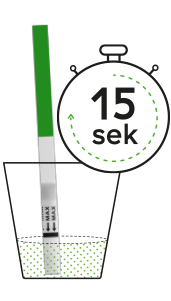
Positive result – LH surge
If two red/pink coloured lines appear in the result area and the red/pink colour of the test line is as strong or darker than the control line, LH surge has been detected. You should ovulate within 24-36 hours. You are most fertile in the next 2 days. If you have sexual intercourse in the next 48 hours, your chances of getting pregnant increase. You can save leftover tests in case you need to test again.

Negative result – No LH surge
If only a control line appears or if the test line appears but is lighter than the control line, there is no LH surge detected in the urine. Continue testing in the coming days.
If you could not detect any LH surge in this cycle, it may be due to the following:
- You may not have had an LH surge in this cycle.
- You may have tested too early or too late in the cycle.
- The amount of LH in your urine may have been too low
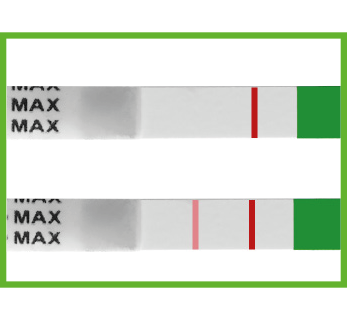
Invalid result
If no control line (C) is visible, no lines are shown at all or the lines are a colour other than red/pink, the test has not worked properly. This may be because the aspirator has not absorbed enough urine or you have not performed the test correctly. Do a new test and follow the instructions carefully. If the problem persists, contact RFSU.
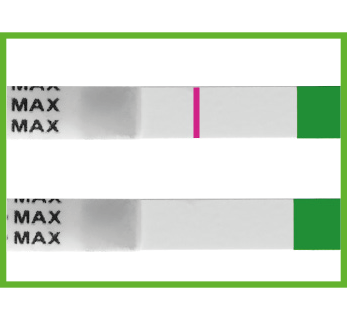
- How to use
-
FAQ
I don’t know how long my menstrual cycle is or I have irregular periods. When should I start testing?
If you don’t know how long your menstrual cycle is, you are advised to wait one cycle and figure out how long it is before you start using the RFSU Ovulation Ovulation Test.
If the length of your menstrual cycle varies more than 3 days, choose the shortest cycle you have had in the last 6 months.
I have recently stopped using hormonal contraceptives (e.g. the pill), can this affect the result?
Your natural hormone production is affected by hormonal contraceptives, and if you have recently stopped taking them, your menstrual cycles may be irregular for some time before stabilising. It may be a good idea to wait until you have had two natural menstrual cycles, and worked out how long they are, before you start using ovulation tests.
I have been taking the ovulation test for 7 days as instructed, but have not been able to detect any LH surge. What should I do?
Testing every day for 5-7 consecutive days is usually sufficient for most women with regular periods. However, if your menstrual cycle varies more than 3 days, you may need to perform additional tests to detect your LH surge. Continue to test to detect your LH surge. It is normal that sometimes there is no ovulation and this may be the reason why you have not been able to detect an LH surge in the current menstrual cycle. Wait until your next menstrual cycle and test
I have been taking the ovulation test for 7 days as instructed, but have not been able to detect any LH surge. What should I do?
Testing every day, for 5-7 consecutive days, is usually sufficient for most women with regular periods. However, if your menstrual cycle varies more than 3 days, you may need to perform additional tests to detect your LH surge. Continue to test to detect your LH surge. It is normal that sometimes there is no ovulation and this may be the reason why you have not been able to detect an LH surge in the current menstrual cycle. Wait until your next menstrual cycle and test again as instructed. If you still cannot detect an LH surge, contact a midwife or gynaecologist for advice.
How reliable is the RFSU Ovulation Ovulation Test?
The ovulation test is 95% reliable in detecting the LH surge that occurs at ovulation, as long as the instructions for the test have been followed carefully.
What should I do if I suspect I am pregnant?
You can use the RFSU Pregnancy Test on the first day of your period.
Do I have to use all the test sticks?
No, you don’t. Continue testing until you have detected the LH surge. You can save the remaining test strips for your next menstrual cycle, if you want to test again.
How long is the result valid?
You can read the result 10 minutes after you have performed the test. Do not read any results after 15 minutes as this may give misleading results.
I have performed the ovulation test, but no control line is displayed. What should I do?
This may be because too much or too little urine has been used on the test stick. Test with a new stick. Follow the instructions for use carefully. If the problem persists, contact RFSU.
Are there factors that can give misleading results?
Always read the manufacturer’s instructions before carrying out the test. Test results are generally not affected by painkillers, antibiotics and other common medicines. Birth control pills and patches containing hCG or LH may affect the test result and should not be used in conjunction with this test. Other factors that may affect the result are if you are taking fertility drugs containing LH or hCG hormone. Check with your doctor. For example, if you are pregnant, have recently been pregnant or have reached the menopause, the result may be misleading.
I have tested your ovulation tests for several days (7 or more) in a row and they show strong lines all the time, what does that mean?
It is individual how high the LH hormone level is in the body, the hormone is constantly in the body and should be increased before ovulation. Most people have weaker LH hormone that increases before ovulation, i.e. the line becomes stronger and stronger the closer you get to ovulation, 2 days before ovulation approximately, the strength of the line should be as strong/or stronger than the control line. If it is unclear and/or you are unsure of your menstrual cycle, test for a couple of months to follow your own cycle and see how the cycle should be in increments.
It may be that you are testing too early in your menstrual cycle and have not yet reached the ovulation period. You can also try testing at other times, for example in the afternoon when the LH hormone may be stronger. It may be that you have so much of the hormone in your body all the time that our ovulation tests do not work for you.


